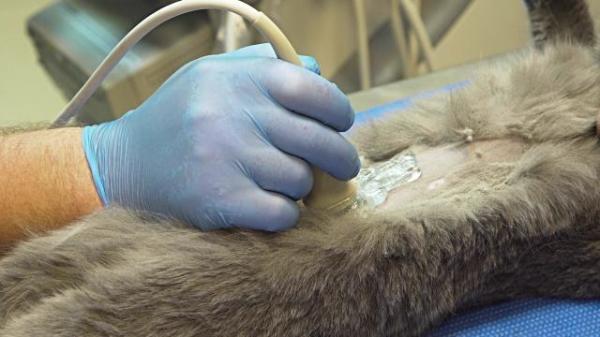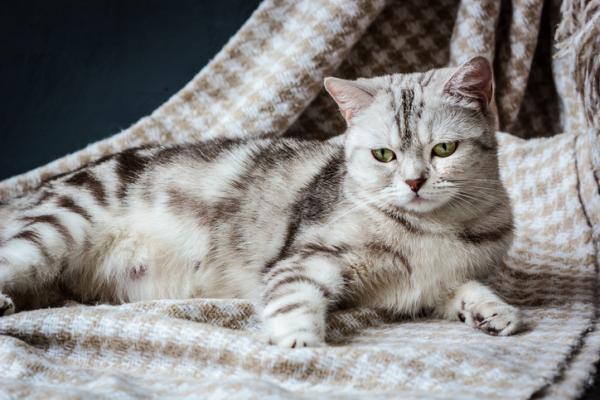Spaying Pregnant Cats - Is It Safe?



See files for Cats
At AnimalWised we try to bring you everything you need to know about your companion animal's care. Unfortunately, this also entails some subjects readers might find upsetting. When a cat becomes pregnant, it brings up issues of responsibility which can be difficult to consider. Cats become parts of families in many different ways. You might purchase a purebreed from a reputable owner or you may bring in a stray who has come to you for shelter. But a cat which has not been neutered can get pregnant if we are not careful. Especially when motivated by their heat cycle, cats can escape and mate outside the home. Some cats we adopt may even be pregnant already.
These situations raises questions about spaying pregnant cats. Are abortions for cats safe? Are there circumstances where they are recommended?
Unwanted pregnancy in cats
Before we explain interrupting the pregnancy of a cat, we should discuss some of the reasons this occurs. For female cats, spaying involves removing the uterus and their eggs. For this reason it is known as an ovariohysterectomy. Since both a fertilized egg and uterus are needed to gestate kittens, the cat will be unable to become pregnant.
For cats which have not been fixed or neutered, they run the risk of pregnancy. They are seasonally polyestrous meaning they can have more than one estrous cycle during certain times of the year. For cats, this is usually during the spring and autumn seasons. They do not have a period like humans. Rather, ovulation is usually induced through copulation. During their heat period, they will be more vocal, more active and will actively seek out a partner. They are more affectionate, will rub against people more and even display their genitals. Importantly, they will often try to escape when they know there is no chance of mating within their home.
The above symptoms will be repeated for approximately one week every fifteen days. If a female cat comes in contact with an unneutered male during this time, it is likely they will mate. The male mounts the female and will copulate until they ejaculate. Cats have a barbed penis which can be painful when removed, but its purpose is to stimulate the release of the egg for fertilization.
Cats can reach sexual maturity after as few as 5 months of age, although it is never recommend for cat breeders to mate them this early. They can also become pregnant at almost any stage, although older cats will have less intense heat cycles and can have more complications when it comes to pregnancy.
The benefit of spaying a cat
Spaying cats does take away their natural ability to have kittens. For many this can seem cruel, but the process of domestication has meant that spaying provides many benefits. These positively affect both the individual cat and the greater feline community in general.
- Less unwanted cats: wild cats will have predators and health issues which negatively affects their population numbers, reducing their life expectancy in the process. Domestic cats generally live much longer with a higher quality of life. This has led to high population numbers, too many for the resources available to us. The result is a higher number of unwanted cats and increased strain on shelter systems.
- Frustration in the cat: since we don't want the cat to become pregnant, we will have to keep our cat away from males. When the cat is in heat, they will become frustrated and act out. This is annoying for guardians as the cat will make loud noises, scratch at doors and generally become bothersome. For the cat, the result is acute frustration, physical pain and stress. In the wild, they will copulate and relieve these symptoms, but when we don't spay the cat, we prolong this period.
- Health risks: pregnancy can bring up different health risks for the cat, especially if they are previously unwell or are suffering from a pre-existing condition. Also, an ovariohysterectomy reduces the chances of certain cancers and other potentially fatal health conditions in cats such as pyometra.
- Greater risk of losing the cat: a cat in heat can go to great lengths to satisfy their natural urges. This puts them at a greater flight risk. Many cats will escape the home to find a mate, but be unable to return to where they came from.

Symptoms of a pregnant cat
If you have seen your cat has been mounted by a male when in heat, it is best to visit a veterinarian to perform an ultrasound and confirm pregnancy. The sooner you identify the pregnancy, the better position you are in to consider termination. There is also less risk to the mother cat's health. However, if you have not witnessed copulation, but you worry your cat may be pregnant, there are some symptoms you can observe. They include:
- Nipples are swollen and reddened
- Vulva is also swollen
- Their belly will distend
- They will seek out quieter places for rest
- Start building a nesting area
- May lose their appetite a little
- In the final phase of cat pregnancy their behavior may change and they become unruly
In general, these symptoms of feline pregnancy will begin during the middle of gestation. During earlier periods, they may be asymptomatic. Unfortunately, as we will see in the next section, this causes abortion in cats to have increased risk.
What to do if a cat is pregnant
There are many reasons why a cat's pregnancy may abort itself naturally. These could be due to microbial infections, but non-infectious causes such as endocrine failure, nutritional problems or even genetic abnormalities might occur[1]. If the pregnancy continues, there are two options:
- Bring to term: if we decide to let the pregnancy continue to full-term, then we will need to carry out veterinary follow-ups, offer special care to the cat and prepare ourselves for the responsibility of a litter of kittens.
- Terminate pregnancy: it is possible to interrupt the pregnancy. This will require going to the veterinarian and discussing your options.
How to interrupt a cat's pregnancy
Once we achieve a confirmation of pregnancy from the vet, they will discuss the options. These will in part be determined by how far along is the pregnancy:
- Initial gestation phases: during the first weeks of the cat's pregnancy, it is unlikely you will notice many physical or behavioral changes. It is only with test carried out by a vet that we can be sure. During these initial stages, the veterinarian may be able to prescribe some drugs which will terminate the pregnancy. These work by causing the body to either reabsorb or expel the fetuses. Another method of terminating the pregnancy is to spay the cat. As we said before, this involves the removal of the uterus. If the cat is pregnant, this means the removal of the fetuses also. Feline abortion drugs are not always effective and they can have side effects. Spaying is a definitive solution for unwanted litters.
- Last weeks of gestation: if we already see the cat's belly has enlarged, we will be dealing with a cat in the final stages of pregnancy. In these cases, the veterinarian will assess the cat's state of health and perform tests to consider the risks of a later-term abortion.
How far along can you spay a pregnant cat?
Although we know the method of how to abort a cat's pregnancy, it may not always be recommended. Feline abortion drugs can be used up to three weeks before the probable date of delivery. Since the due date can be difficult to determine if we don't know when fertilization took place, it is not always possible to leave it that late. After this time they may be either ineffective or cause side effects.
Spaying pregnant cats is something which will likely be done at the discretion of the vet. However, those who would have a problem with this procedure on moral grounds are in the minority. Few more than vets know the problem that unwanted cats can bring. These cats put strain on already scant resources and many will go into a system where they can't be rehoused. For kill-shelters, this means they will be killed after they have had a chance to experience some life, which can seem more cruel than aborting earlier.
Some veterinarians will carry out a termination at any stage of the pregnancy. Others may not wish to carry it out after two weeks before the due date as they are worried about health complications for the mother. This is due to the accumulation of blood that can occur in the womb during gestation.
Spaying pregnant dogs is a complicated issue, but a qualified and experienced veterinarian should be able to discuss the options with you. The strain of unwanted kittens and the quality of life they will experience are big factors. So too is the health of the mother. Animal guardians need to make considerations for their family also, so available resources may make the decision for us.
Even if the pregnancy is further along, spaying a pregnant cat is usually fairly safe. There may be some complications (e.g. if the cat is obese or has a health issue), but spaying is a relatively safe procedure and complications are rare.

How to avoid pregnancy in cats
To avoid the difficult decision of whether to terminate a cat's pregnancy, prevention is imperative. As cat guardians, it is our responsibility to ensure the welfare of our felines. Sterilization is recommended for companion cats. There are drugs which can be taken to inhibit the heat cycle, but they are not always effective and possible side effects include breast tumors or uterine infection. They are not advised for use as a permanent contraceptive.
Many of use think it might be a good idea to start breeding cats, whether out of a desire to make money or because you like the idea of having kittens. However, many still don't appreciate the responsibility this brings. They think there will be lots of families wanting to adopt the kittens, but this is not necessarily true. In the USA alone, 3.2 million cats are entered into the shelter system per year, about 860,000 of which are euthanized[2]. Adding more will only exacerbate the problem.
Unwanted cats also add to the problem of increased feral cat populations. These cats come form unwanted domestic cats who have to live outside and fend for themselves. TNR (trap-neuter-release) schemes[3] have shown some success in reducing these populations and improving the welfare of cats in general.
This article is purely informative. AnimalWised does not have the authority to prescribe any veterinary treatment or create a diagnosis. We invite you to take your pet to the veterinarian if they are suffering from any condition or pain.
If you want to read similar articles to Spaying Pregnant Cats - Is It Safe?, we recommend you visit our Pregnancy problems category.







